This article was co-authored by Lydia Shedlofsky, DO. Dr. Lydia Shedlofsky is a Resident Dermatologist who joined Affiliated Dermatology in July of 2019 after completing a traditional rotating internship at Larkin Community Hospital in Miami, Florida. She earned a Bachelor of Science in Biology at Guilford College in Greensboro, North Carolina. After graduation, she moved to Beira, Mozambique, and worked as a research assistant and intern at a free clinic. She completed a Post-Baccalaureate program and subsequently earned a Master's Degree in Medical Education and a Doctorate of Osteopathic Medicine (DO) from the Lake Erie College of Osteopathic Medicine.
There are 11 references cited in this article, which can be found at the bottom of the page.
This article has been viewed 111,204 times.
Ringworm, or tinea corporis, is a common fungal infection. Athlete’s foot and jock itch are two forms, while ringworm can also infect the scalp or any other area of skin’s surface. By keeping your skin clean and avoiding potential sources of infection, you can likely prevent yourself from catching a ringworm. If you or a family member are infected, there are also safe and easy steps to rid yourself of the infection and prevent it from spreading.[1]
Steps
Keeping Your Skin Clean and Dry
-
1Wash and dry your skin frequently. Keeping your skin clean is the best way to prevent a ringworm infection. Dark, warm areas of your body are the spots where the fungus can grow most easily, but a ringworm infection can occur almost anywhere on your body. Wash your entire body with soap and water every day, making sure to give attention to your feet, groin, and scalp.[2]
- Change your socks and underwear daily.
- Physical activity in warm, humid weather or while wearing thick clothing in cold weather can increase the likelihood of an ringworm infection. Be sure to wash with soap and water after any physical activity that caused you to sweat heavily.
-
2Take particular care in keeping your feet clean and dry. Feet provide the perfect environment for fungus to grow. To avoid exposing yourself to ringworm, wear sandals in locker rooms and public showers. Further, keep your toenails cut short and clean them whenever you wash the rest of your body.[3]
- If possible, wear footwear that allow your feet access to air, such as supportive sandals.
Advertisement -
3Wash yourself immediately after playing contact sports. Take a shower as soon as you conclude playing a sport or anything else that involves skin-to-skin contact with other people. Use soap, and don’t forget to wash everywhere on your body that came into contact with others, as well as anywhere sweat may have collected, including your feet, groin, and scalp.[4]
-
4Don’t share used personal items with others. Particularly if there is a chance someone may have ringworm, take care to avoid wearing anything that they’ve worn before it’s been properly cleaned. This may include either clothing or sporting equipment, such as a baseball helmet. Similarly, don’t use towels or sleep in sheets used by someone who may be infected with ringworm.[5]
- Know that the fungi that cause infections such as ringworm can remain on many different types of items, from hairbrushes to furniture.[6]
- Be sure to wear socks when using rental items such as bowling shoes or skates.
Treating Ringworm Infection
-
1Recognize signs of ringworm infection on the skin. Ringworm is often visibly apparent, as it usually results in red, scaly patches or rounded bumps on the skin. Even before there are visible signs, however, an infected patch of skin will become very itchy. Actual rings of reddened, raised, and scaly skin may develop, though ringworm may be present without these rings.[7]
- Neither athlete’s foot nor jock itch lead to the formation of actual rings. Rather, these infections will lead to itchy, red, and scaly patches.
- Avoid scratching or otherwise irritating ringworm infections, as this may spread the infection and can also lead to bacterial superinfection.
-
2Watch for ringworm on the scalp and nails as well. Ringworm on the scalp usually appears initially as a small round bump that may look like a pimple; however, the spot will quickly become flaky, irritated, red, and/or scaly. Hair may even fall out. Additionally, watch for lightening of the color of the nails, or increased brittleness, as these symptoms may also indicate a ringworm infection.[8]
-
3Watch children in particular for signs of ringworm. Children are especially likely to be exposed to ringworm, and are less likely to acknowledge initial symptoms as signs of an infection that needs to be addressed. Further, schools are sites at which outbreaks of ringworm commonly occur. As such, watch out for signs of infection in kids and get children treated as quickly as possible.[9]
- Factors that increase the risk of ringworm infection in children also include more frequent use of communal showers, participation in contact sports, and suppressed immune systems. These all also contribute to the rapid spread of ringworm among children.
-
4Begin treatment as soon as possible. Regardless of the site or intensity of an infection or the age of the person infected, act immediately to treat the infection and prevent its spread. You do not need to avoid work or keep kids from going to school, as ringworm is not dangerous.[10]
- In particular, ensure any children that are infected or at risk of infection are washing frequently.
-
5Treat ringworm on your skin with over-the-counter products. Many cases of ringworm, particularly athlete’s foot and jock itch, can be treated with non-prescription medications. There are various lotions, creams, gels, sprays and powders you can apply to affected areas every day. These medications should clear your infection within to to four weeks.[11]
- Look for a medication that includes clotrimazole, miconazole, terbinafine, or ketoconazole.
- Follow the specific instructions on the packaging of whichever over-the-counter medication you acquire. Usually, you’ll want to cover the visible infection and the area immediately surround the infection.
- Note that creams, lotions, and powders will not rid a case of ringworm on the scalp.
-
6Treat more serious cases with prescriptions antifungal medication. If your ringworm infection worsens or persists beyond a few weeks, see a doctor. Ringworm on the scalp is especially likely to persist without prescription medications, which are often prescribed as oral medications that will need to be taken for one to three months.[12]
- Your doctor may check your liver function with a blood test before starting the oral medications. Some antifungal medications can have adverse affects on the liver, especially in those with liver disease.
- There are several antifungal prescription medications, including griseofulvin, terbinafine, itraconazole, and fluconazole.
Preventing Your Pet’s Ringworm From Spreading
-
1Wash your hands after touching your pet. You should always wash your hands with soap and water immediately after playing with your pets, as cats and dogs can both catch ringworm, not to mention various other illnesses. If you believe your pet may have ringworm, take them to the vet as soon as possible. In the meantime, take steps to prevent you or anyone else from catching ringworm from your pet.[13]
- If your pet’s hair becomes patchy, or you’ve noticed scratching more frequently than usual, get them to vet!
-
2Protect your own skin if your pet is infected.[14] Wear clothing with long sleeves and gloves when handling a pet that may be infected with ringworm. If your immune system is in any way compromised by illness or medication, do not handle the pet at all.[15]
- If the vet reports that your pet does indeed have ringworm, be sure to have any other pets checked as well.
-
3Disinfect the areas where your pet likes to spend time. Ringworm may be present on bits of your pet’s skin and hairs that are shed around your home. Clean any of the areas where they spend time, including any furniture or bedding.[16]
- Use a gallon of water with a ¼ cup of bleach added, a cleaning solution with benzalkonium chloride, or a strong detergent to clean surfaces and materials.
Expert Q&A
Did you know you can get expert answers for this article?
Unlock expert answers by supporting wikiHow
-
QuestionHow is ringworm spread?
 Lydia Shedlofsky, DODr. Lydia Shedlofsky is a Resident Dermatologist who joined Affiliated Dermatology in July of 2019 after completing a traditional rotating internship at Larkin Community Hospital in Miami, Florida. She earned a Bachelor of Science in Biology at Guilford College in Greensboro, North Carolina. After graduation, she moved to Beira, Mozambique, and worked as a research assistant and intern at a free clinic. She completed a Post-Baccalaureate program and subsequently earned a Master's Degree in Medical Education and a Doctorate of Osteopathic Medicine (DO) from the Lake Erie College of Osteopathic Medicine.
Lydia Shedlofsky, DODr. Lydia Shedlofsky is a Resident Dermatologist who joined Affiliated Dermatology in July of 2019 after completing a traditional rotating internship at Larkin Community Hospital in Miami, Florida. She earned a Bachelor of Science in Biology at Guilford College in Greensboro, North Carolina. After graduation, she moved to Beira, Mozambique, and worked as a research assistant and intern at a free clinic. She completed a Post-Baccalaureate program and subsequently earned a Master's Degree in Medical Education and a Doctorate of Osteopathic Medicine (DO) from the Lake Erie College of Osteopathic Medicine.
Dermatologist
-
QuestionCan you get ringworm from pets?
 Lydia Shedlofsky, DODr. Lydia Shedlofsky is a Resident Dermatologist who joined Affiliated Dermatology in July of 2019 after completing a traditional rotating internship at Larkin Community Hospital in Miami, Florida. She earned a Bachelor of Science in Biology at Guilford College in Greensboro, North Carolina. After graduation, she moved to Beira, Mozambique, and worked as a research assistant and intern at a free clinic. She completed a Post-Baccalaureate program and subsequently earned a Master's Degree in Medical Education and a Doctorate of Osteopathic Medicine (DO) from the Lake Erie College of Osteopathic Medicine.
Lydia Shedlofsky, DODr. Lydia Shedlofsky is a Resident Dermatologist who joined Affiliated Dermatology in July of 2019 after completing a traditional rotating internship at Larkin Community Hospital in Miami, Florida. She earned a Bachelor of Science in Biology at Guilford College in Greensboro, North Carolina. After graduation, she moved to Beira, Mozambique, and worked as a research assistant and intern at a free clinic. She completed a Post-Baccalaureate program and subsequently earned a Master's Degree in Medical Education and a Doctorate of Osteopathic Medicine (DO) from the Lake Erie College of Osteopathic Medicine.
Dermatologist
References
- ↑ https://www.cdc.gov/fungal/diseases/ringworm/risk-prevention.html
- ↑ https://www.aad.org/public/diseases/a-z/ringworm-self-care
- ↑ https://www.cdc.gov/fungal/diseases/ringworm/risk-prevention.html
- ↑ https://www.nationwidechildrens.org/conditions/ringworm
- ↑ https://myhealth.alberta.ca/Health/aftercareinformation/pages/conditions.aspx?hwid=zc1361
- ↑ https://www.nhsinform.scot/illnesses-and-conditions/infections-and-poisoning/ringworm-and-other-fungal-infections#preventing-ringworm-and-other-fungal-infections
- ↑ https://www.aad.org/public/diseases/a-z/ringworm-symptoms
- ↑ https://www.aad.org/public/diseases/a-z/ringworm-symptoms
- ↑ https://kidshealth.org/en/parents/fungal-ringworm.html
- ↑ https://www.nhs.uk/conditions/ringworm/
- ↑ https://www.cdc.gov/fungal/diseases/ringworm/treatment.html
- ↑ https://www.cdc.gov/fungal/diseases/ringworm/treatment.html
- ↑ https://www.cdc.gov/healthypets/diseases/ringworm.html#tabs-1-2
- ↑ Lydia Shedlofsky, DO. Dermatologist. Expert Interview. 11 November 2020.
- ↑ https://www.cdc.gov/healthypets/diseases/ringworm.html#tabs-1-2
- ↑ https://www.aad.org/public/diseases/a-z/ringworm-self-care
- ↑ Lydia Shedlofsky, DO. Dermatologist. Expert Interview. 11 November 2020.
About This Article
To prevent ringworm infections like athlete's foot and jock itch, make sure to wash and dry your feet, groin, and scalp daily. You should also change into a fresh pair of socks and underwear every day, and shower right after playing contact sports or any time you work up a real sweat. Furthermore, avoid sharing personal items, like helmets or towels, with other people, as the type of fungi that causes ringworm can remain on many types of surfaces. Additionally, because dogs and cats can catch ringworm, too, remember to wash your hands with soap and water after every play session. For more advice from our Medical co-author, like how to treat ringworm infection, keep reading.

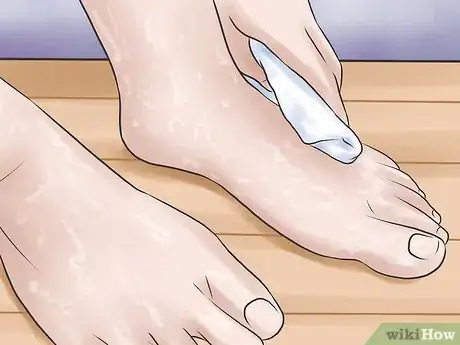

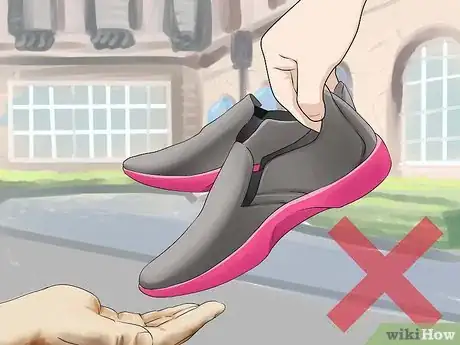






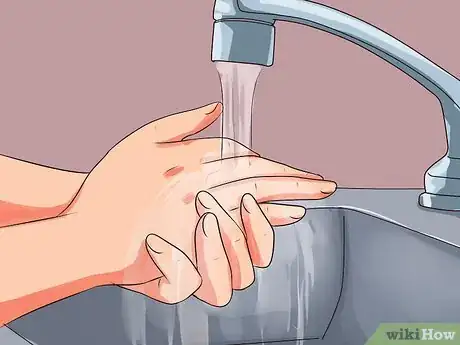











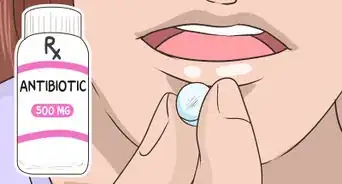
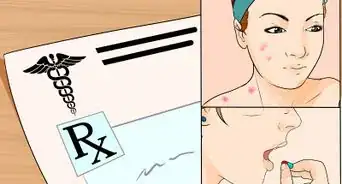












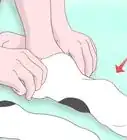





































Medical Disclaimer
The content of this article is not intended to be a substitute for professional medical advice, examination, diagnosis, or treatment. You should always contact your doctor or other qualified healthcare professional before starting, changing, or stopping any kind of health treatment.
Read More...